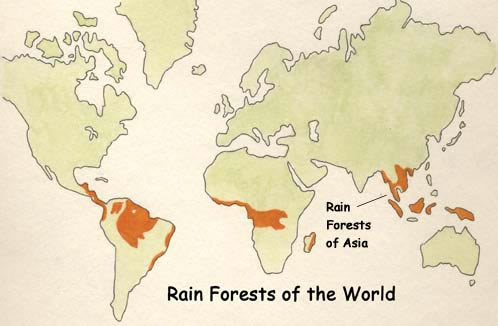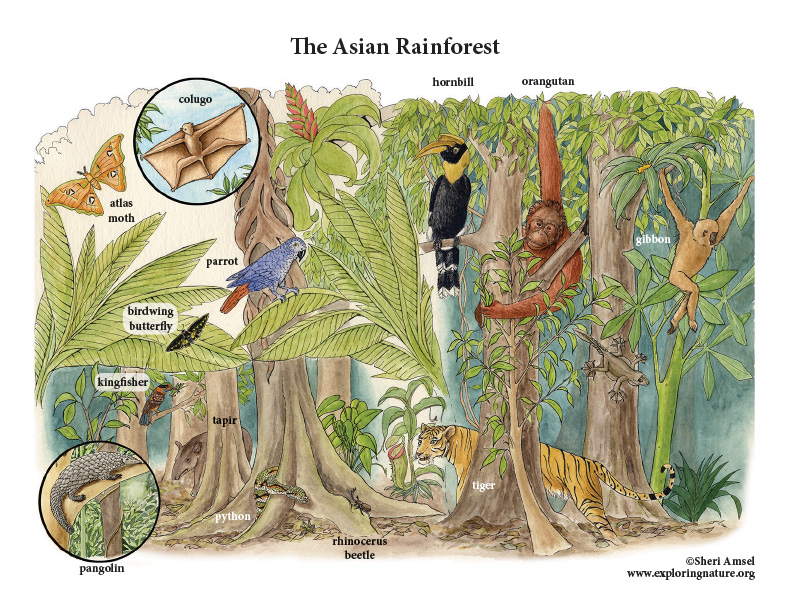

The Asian rainforests are found on Borneo, Sumatra, the Malay Peninsula, and many islands including New Guinea.
Rainforests get about 60 inches of rain each year. That is about 1/8 of an inch every day. The air is hot and humid, a good combination for plant growth. The trees grow so thick that falling rain often never reaches the ground.
A giant flying mammal, called the colugo, searches for fruits and flowers. It glides, making a greenish gray flash, from tree to tree. Flying lizards also glide through the trees. They don't really fly at all but spread flaps of skin or webbed toes to catch the air. Real flyers, like the hornbill, flap through the forest in search of food. The forest kingfisher munches on a katydid. Huge orange orangutans lumber from branch to branch, feeding on fruit and stripping leaves with their long fingers and teeth. Gibbons and proboscis monkeys also share the treetops. Later at night giant fruit-eating bats will wake up to search for ripe fruit. Tigers are the biggest meat eaters here as they search the forest floor for a tapir, tree shrew or barking deer. Pythons also hunt for unwary animals. The trees in the Asian rain forest are also home for many strange insects. The bright green leaf beetle shines in the light but blends so well into the dark leaves that it easily hides from its enemies. Crickets, walking sticks, long-horned and rhinoceros beetles also hide among the leaves. Some insects, like the flower mantid, are the color of the leaves and flowers they live on. This camouflage hides them safely in the forest. Large atlas moths and birdwing butterflies flutter by.
The tapang tree is the tallest rain forest tree in the world. Strangler figs live in this forest, too, rooting in other trees. Teak trees are treasures for their precious wood, and wild ginger is a valued spice. Up on stilted roots, the screw pine is a strange sight. Because of the thin topsoil layer in rain forests, trees have shallow, widely spreading roots. As a result, the trees are easier to log because they can be simply knocked over with a bulldozer. Everywhere liana vines hang from trees, and ferns and flowers give the forest color. The pitcher plant takes advantage of the forest’s many insects by trapping them in its long neck and then dissolving them in the acid at the bottom.
Related Resources:
Asian Rainforest Color Mini-Poster
Related Activity:
Asian Rainforest Coloring Page
Related Testing and Assessment:
Asian Rainforest Labeling Page
Asian Rainforest - Read and React Quiz
When you research information you must cite the reference. Citing for websites is different from citing from books, magazines and periodicals. The style of citing shown here is from the MLA Style Citations (Modern Language Association).
When citing a WEBSITE the general format is as follows.
Author Last Name, First Name(s). "Title: Subtitle of Part of Web Page, if appropriate." Title: Subtitle: Section of Page if appropriate. Sponsoring/Publishing Agency, If Given. Additional significant descriptive information. Date of Electronic Publication or other Date, such as Last Updated. Day Month Year of access < URL >.
Amsel, Sheri. "Asian Rainforest" Exploring Nature Educational Resource ©2005-2024. December 13, 2024
< http://www.exploringnature.org/db/view/1742 >

